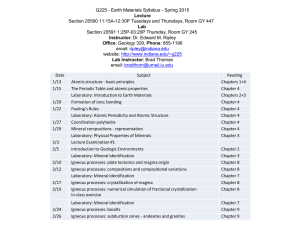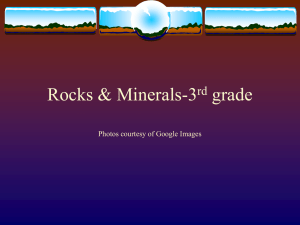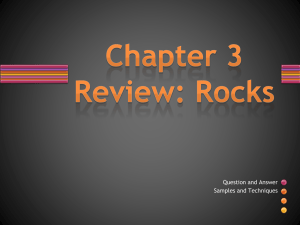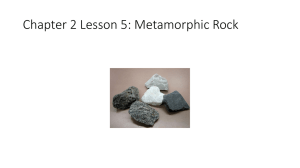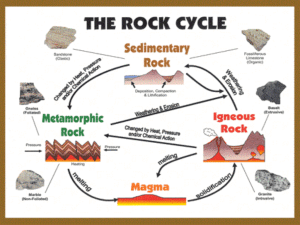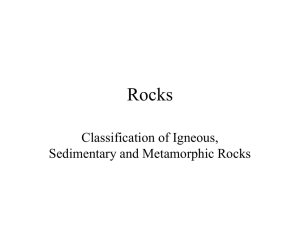ANSWER
advertisement
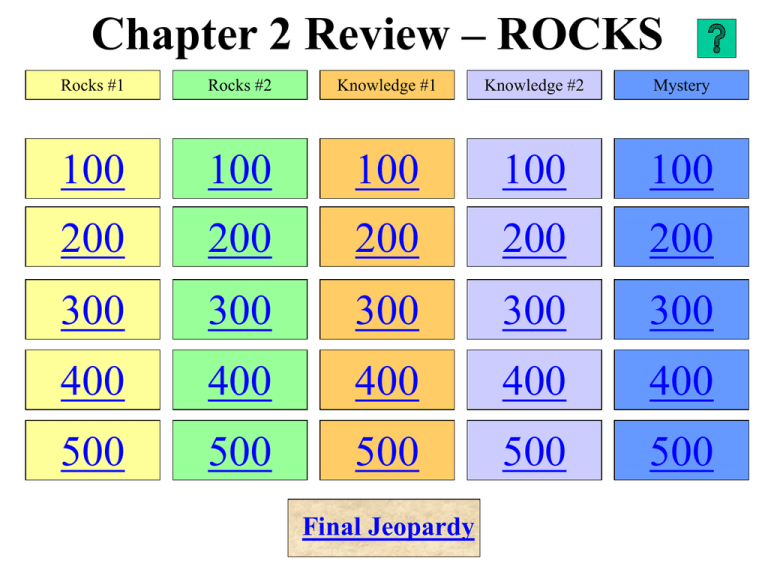
Chapter 2 Review – ROCKS Rocks #1 Rocks #2 Knowledge #1 Knowledge #2 Mystery 100 100 100 100 100 200 200 200 200 200 300 300 300 300 300 400 400 400 400 400 500 500 500 500 500 Final Jeopardy Help (1) Save a duplicate of this template. (2) Enter all answers and questions in the normal view. (view/normal) (3) Change the category headings in the normal view (view/normal) (4) View as a slideshow. (5) Use the home red button after each question. ©Norman Herr, 2003 Rocks #1 - 100 • QUESTION: Pull out pumice. Name the major rock group for pumice (sedimentary, metamorphic, igneous). Name the specific category for pumice (foliated, non-foliated, extrusive, intrusive, clastic, chemical, organic). Name the texture (fine-grained or coarsegrained). • ANSWER: igneous, extrusive, fine-grained Answer Question Rocks #1 - 200 • QUESTION: Pull out gneiss. Name the major rock group for gneiss (sedimentary, metamorphic, igneous). Name the specific category for gneiss (foliated, non-foliated, extrusive, intrusive, clastic, chemical, organic). Name the texture (fine-grained or coarsegrained). • ANSWER: metamorphic, foliated, coarse-grained Answer Question Rocks #1 - 300 • QUESTION: Pull out granite. Name the major rock group for granite (sedimentary, metamorphic, igneous). Name the specific category for granite (foliated, non-foliated, extrusive, intrusive, clastic, chemical, organic). Name the texture (fine-grained or coarsegrained). • ANSWER: igneous, intrusive, coarse-grained Answer Question Rocks #1 - 400 • QUESTION: Pull out marble. Name the major rock group for marble (sedimentary, metamorphic, igneous). Name the specific category for marble (foliated, non-foliated, extrusive, intrusive, clastic, chemical, organic). Name the texture (fine-grained or coarsegrained). • ANSWER: metamorphic, non-foliated, coarse-grained Answer Question Rocks #1 - 500 • QUESTION: Pull out schist. Name the major rock group for schist (sedimentary, metamorphic, igneous). Name the specific category for schist (foliated, non-foliated, extrusive, intrusive, clastic, chemical, organic). Name the texture (fine-grained or coarse-grained). • ANSWER: metamorphic, foliated, coarse-grained Answer Question Rocks #2 - 100 • QUESTION: Pull out obsidian. Name the major rock group for obsidian (sedimentary, metamorphic, igneous). Name the specific category for obsidian (foliated, non-foliated, extrusive, intrusive, clastic, chemical, organic). Name the texture (fine-grained or coarsegrained). • ANSWER: igneous, extrusive, fine-grained Answer Question Rocks #2 - 200 • QUESTION: Pull out conglomerate. Name the major rock group for conglomerate (sedimentary, metamorphic, igneous). Name the specific category for conglomerate (foliated, non-foliated, extrusive, intrusive, clastic, chemical, organic). Name the texture (fine-grained or coarsegrained). • ANSWER: sedimentary, clastic, coarse-grained Answer Question Rocks #2 - 300 • QUESTION: Pull out basalt. Name the major rock group for basalt (sedimentary, metamorphic, igneous). Name the specific category for basalt (foliated, non-foliated, extrusive, intrusive, clastic, chemical, organic). Name the texture (fine-grained or coarsegrained). • ANSWER: igneous, extrusive, fine-grained Answer Question Rocks #2 - 400 • QUESTION: Pull out sandstone. Name the major rock group for sandstone (sedimentary, metamorphic, igneous). Name the specific category for sandstone (foliated, non-foliated, extrusive, intrusive, clastic, chemical, organic). Name the texture (fine-grained or coarsegrained). • ANSWER: sedimentary, clastic, fine-grained Answer Question Rocks #2 - 500 • QUESTION: Pull out slate. Name the major rock group for slate (sedimentary, metamorphic, igneous). Name the specific category for slate (foliated, non-foliated, extrusive, intrusive, clastic, chemical, organic). Name the texture (fine-grained or coarse-grained). • ANSWER: metamorphic, foliated, fine-grained Answer Question Knowledge #1 - 100 • QUESTION: Compare & contrast magma & lava. • ANSWER: compare – both come from volcanoes contrast – magma is in the Earth, lava is on the surface of the Earth Answer Question Knowledge #1 - 200 • QUESTION: Which rock can be both organic & chemical? • ANSWER: limestone Answer Question Knowledge #1 - 300 • QUESTION: Define chemical. • ANSWER: a sedimentary rock formed when minerals dissolved in a water solution crystallize Answer Question Knowledge #1 - 400 • QUESTION: Pull out shale. Name the major rock group for shale (sedimentary, metamorphic, igneous). Name the specific category for shale (foliated, non-foliated, extrusive, intrusive, clastic, chemical, organic). Name the texture (fine-grained or coarse-grained). • ANSWER: sedimentary, clastic, fine-grained Answer Question Knowledge #1 - 500 • QUESTION: What are the 3 tools / characteristics that geologists use to classify rocks once they have formed? • ANSWER: texture, color, & mineral composition Answer Question Knowledge #2 - 100 • QUESTION: Define igneous rock. • ANSWER: rock formed from the cooling of magma or lava Answer Question Knowledge #2 - 200 • QUESTION: Which major group is rock particles bound together with natural cement? • ANSWER: sedimentary Answer Question Knowledge #2 - 300 • QUESTION: Fill in the blank with one word ONLY. You can find many ___________ in organic rocks. • ANSWER: fossils Answer Question Knowledge #2 - 400 • QUESTION: Name an igneous, intrusive rock that cooled very slowly. • ANSWER: granite or gabbro Answer Question Knowledge #2 - 500 • QUESTION: Pull out gabbro. Name the major rock group for gabbro (sedimentary, metamorphic, igneous). Name the specific category for gabbro (foliated, non-foliated, extrusive, intrusive, clastic, chemical, organic). Name the texture (fine-grained or coarsegrained). • ANSWER: igneous, intrusive, coarse Answer Question Mystery - 100 • QUESTION: Define coarse-grained. • ANSWER: the grains in a rock are large enough to see Answer Question Mystery - 200 • QUESTION: Name 2 words that describe the formation of metamorphic rocks. • ANSWER: heat, pressure Answer Question Mystery - 300 • QUESTION: Why does pumice have holes in it? • ANSWER: gas bubbles were trapped in the lava as it cooled very fast Answer Question Mystery - 400 • QUESTION: Fill in the blank with one word ONLY. When we refer to texture we are referring to the ___________ of the rocks. • ANSWER: grain Answer Question Mystery - 500 • QUESTION: List the 5 steps that describe the formation of sedimentary rocks. Give a oneword definition for each. • ANSWER: 1. weathering - break 2. erosion – move 3. deposition – drop 4. compaction – compress / squeeze 5. cementation – glue Answer Question FINAL JEOPARDY • QUESTION: What is the difference between a limestone that is organic and a limestone that is chemical? • ANSWER: organic = limestone made from shells chemical = limestone made from calcite Answer Question

